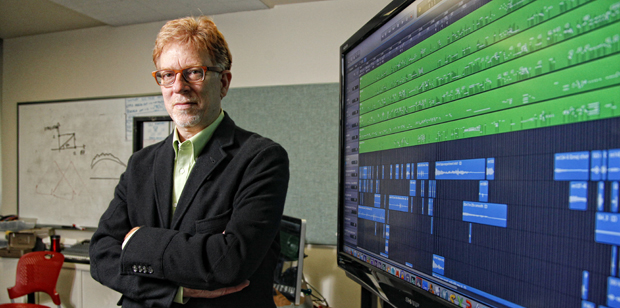Eric Chasalow composes music that fuses electronic with traditional
Chasalow is celebrating his 60th birthday year, a major milestone for composers
 Photo/Mike Lovett
Photo/Mike Lovett| Watch Eric Chasalow give a Buchla 100 lesson |
In front of a vintage Buchla synthesizer, audio cables draped around his neck, Dean of the Graduate School of Arts and Sciences and Irving Fine Professor of Music Eric Chasalow looks more the part of a mad scientist than composer of music. But there is a method to his musical experiments.
“How can we create something new by taking apart something that already exists and turning it into something else?” Chasalow said. “Once you've got something recorded -- it could be something written for a piano, or sounds from walking on the beach, or a poem -- you can stretch it out, cut words apart, completely re-contextualize it and turn it into something else. That's a process I love.”His pieces, which are played around the world, often fuse together electronic sounds with traditional instruments, challenging the listener’s notions about an instrument or style, taking them to a new place.
“The possibility of combining so completely the electronic with the traditional that you can't tell where one ends and the other begins is very powerful to me,” he said.
In celebration of his 60th birthday – a major milestone for composers – Chasalow has released a new CD and book, and a concert featuring the Dinosaur Annex Ensemble will be held in his honor Oct. 24 at Slosberg Music Center.
Listen: "On that Swirl of Ending Dust," one of Chasalow's pieces that will be performed Oct. 24:
Chasalow took some time to talk with BrandeisNOW about his style of composing and the use of electronics in music:
How did you start experimenting with electronic sounds in music?
I was introduced to it in the late 1960s. That was the beginning of synthesizers. The Moog and the Buchla are both from the 1960s. I was writing big band charts in high school and the guys who ran a local music store saw I had won an award at a competition and offered me a portable synthesizer to experiment with. It was an ARP Odyssey, one of the early portable synthesizers - a little box about 3 square feet that could do a few things. I started experimenting with that, and I had a tape recorder and I started experimenting with that. Around that time I also heard Morton Subotnick's “Silver Apples of the Moon.” I couldn't make much sense of it musically, but I was certainly interested in what I heard.
The synthesizer must have been an important development for electronics in music.
There are a couple of landmarks we point to in the history of electronic music and the synthesizer is one of them. Before that, the studio consisted of a lot of equipment that was meant for other things - separate devices that had to be rigged up to make them work. The idea of the synthesizer was to take those different devices and put them into one box that could be used, sort of as one instrument.
People are going nuts for old synthesizers now. I lived through that time where we moved away from the old synthesizers to new ones that were more compact, then ultimately away from synthesizers completely to software, doing it entirely on the computer. Now people are buying vinyl records, they want to record on reel-to-reel tape, not digitally, and people want to use analog synthesizers. I never gave it up. There's something so tactile about using analog synthesizers. One of my next records is going to be entirely made with the Buchla. There's so much interest in this now, young people are discovering it, there's a whole community doing analog synthesis, and there are new companies building them. I'm thinking, how can I go back to that old machine, can I re-imagine, come up with something new, how can I work against the limitations of that machine to make something interesting? How can I get it to do something that's not natural for it, to express something in a different way?
Your music often brings together the electronic with the traditional. How to you view the relationship between electronic methods and traditional instruments in music?
All instruments are machines, but that doesn't change the fact that when you start getting into the world of electronic music, the machines are different in a number of ways that makes the music different, that changes the way we think about music. For one thing, especially with early electronic music, I'm talking the middle of the 20th century, it was not something people were performing in real time on a stage. They were working in studios and constructing something, kind of the way a sculptor works, and that sets it apart from the way other music is made. Historically, it's been separated from other music because of that. But as a composer, ever since it has been introduced to me, it was just another group of instruments that were really interesting that you could do different things with.
Listen: Chasalow's "Due (Cina)mani:"
Eric Chasalow's 60th Birthday Concert will be held Saturday, Oct. 24 at Slosberg Music Center. The concert, which is free and open to the public, will showcase two of Chasalow’s works— “On That Swirl of Ending Dust,” a sextet with electronics, and “Due (Cinta)mani” for piano and electronics, performed by the Dinosaur Annex Ensemble. Two other Brandeis music faculty members—Yu-Hui Chang and David Rakowski—have written works as a birthday tribute, which will be premiered at this concert. Dinosaur Annex will also perform Quartetto No.4 for clarinet and strings by Mario Davidovsky.
Categories: Arts





